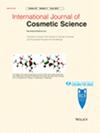Reinforcing chemically treated human hair with citric acid
Abstract
Objective
The objective of this work was to conduct a systematic study to evaluate the performance of citric acid (CA), an example of a commonly used organic acid in hair cosmetics, on different types of chemically treated hair and to better understand how CA works.
Methods
Consumer-centric routines were used to prepare the chemically treated hair, namely high-lift bleached, middle-lift bleached, permanently coloured and a combination of permed and coloured hair. Hair was subsequently treated with CA and hair reinforcement was investigated by physical techniques: High Pressure Differential Scanning Calorimetry (HPDSC), Miniature Tensile Test (MTT), Cyclic Fatigue Tensile Test (CFTT) & Micro X-ray Diffraction (μXRD) as well as chemical analysis (elemental, amino acids).
Results
CA treatment demonstrably enhances the structural integrity of chemically treated hair. DSC revealed increased crosslinking density of keratin-associated proteins (KAPs) in the hair cortex, evidenced by a 6.7% to 15.0% increase in denaturation temperature, varying with the specific chemical treatment. This improvement translates to enhanced mechanical properties, with tensile elastic modulus increasing by 7.5% to 23.5% and fatigue resistance (median cycles to break) improving by a remarkable 56% to 124%. Furthermore, CA treatment significantly reduced hair calcium levels by 21% to 42%. XRD analysis confirmed a reduction in the structure and quantity of crystallized calcium soaps following CA treatment. The observed performance improvements likely stem from a combination of mechanisms, including calcium chelation, the treatment's pH, and reinforcement of the non-covalent protein network. The precise interplay of these factors appears to be influenced by the type of pre-existing chemical treatment on the hair.
Conclusion
CA effectively reinforces hair damaged by various common chemical treatments. However, these findings highlight the complex relationship between hair damage, chemical treatment type, and the efficacy of reinforcement strategies. The observed dependence of CA's performance on the level of pre-existing damage underscores the need for further research into developing targeted actives for consumers with specific and severe hair damage profiles. This opens exciting avenues for innovation in hair care tailored to individual needs.

 求助内容:
求助内容: 应助结果提醒方式:
应助结果提醒方式:


